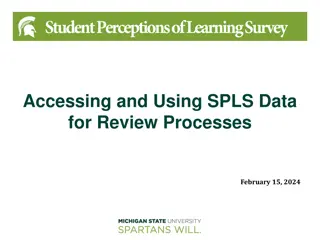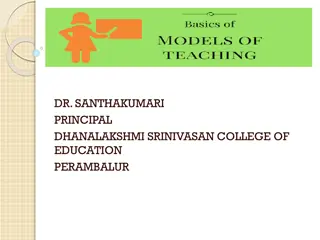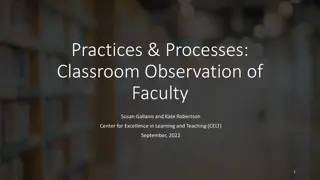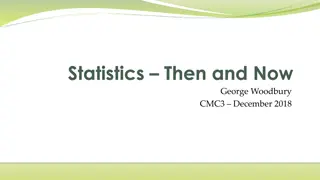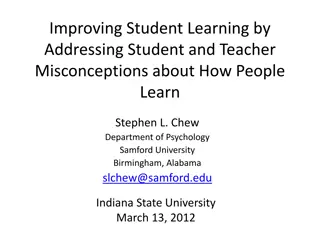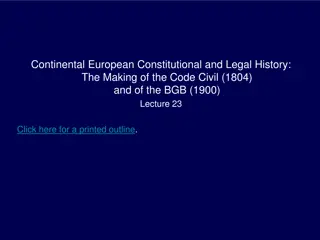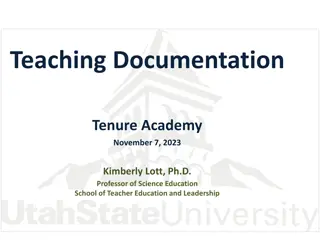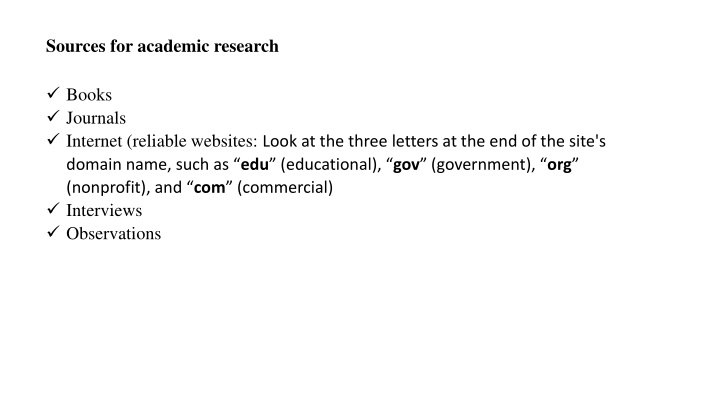
Effective Academic Research Sources and Citation Guidelines
Explore the importance of primary and secondary data sources, understand the difference between them, learn about using DOI in academic journals, and master proper citation techniques for research papers and assignments.
Download Presentation

Please find below an Image/Link to download the presentation.
The content on the website is provided AS IS for your information and personal use only. It may not be sold, licensed, or shared on other websites without obtaining consent from the author. If you encounter any issues during the download, it is possible that the publisher has removed the file from their server.
You are allowed to download the files provided on this website for personal or commercial use, subject to the condition that they are used lawfully. All files are the property of their respective owners.
The content on the website is provided AS IS for your information and personal use only. It may not be sold, licensed, or shared on other websites without obtaining consent from the author.
E N D
Presentation Transcript
Sources for academic research Books Journals Internet (reliable websites: Look at the three letters at the end of the site's domain name, such as edu (educational), gov (government), org (nonprofit), and com (commercial) Interviews Observations
Two types of information sources: Primary sources: Sources that provide primary data such as interviews, observations, and questionnaires are called primary sources. Secondary sources: Sources that provide secondary data are called secondary sources. Sources such as books, journals, previous research studies, records of an agency, and client or patient information already collected. Example: 1. A novel and a literary criticism of the novel 2. Data from a student survey
BASIS FOR COMPARISON PRIMARY DATA SECONDARY DATA Meaning Primary data refers to the first hand data gathered by the researcher himself. Secondary data means data collected by someone else earlier. Data Real time data Past data Process Very involved Quick and easy Source Surveys, observations, experiments, questionnaire, personal interview, etc. Government publications, websites, books, journal articles, internal records etc. Cost effectiveness Expensive Economical Collection time Long Short Specific Always specific to the researcher's needs. May or may not be specific to the researcher's need.
Journals and DOI A DOI (Digital Object Identifier) code is a unique and permanent string of letters and numbers representing an article or document that will take you to that article wherever it is located on the Web. DOI numbers provide a permanent link to an article and are required for many citation styles. Question: Should I use the entire web address or just the DOI in my reference list? Answer: Whenever possible, include the DOI at the end of the reference entry. If a DOI is not present, it is ok to use the URL. (APA, 2020, pp.298-301) For example, if you have the following URL http://dx.doi.org.ezproxy.library.wwu.edu/10.1177/0017896911419346 you should reformat it to http://dx.doi.org/10.1177/0017896911419346 Use only academic articles not any general source or page or website or personal blog.
Citation note: (In text citation) Noam Chomsky, Aspects of the Theory of Syntax, 1965 (Surname, year, p.)= (Chomsky, 1965, p.11) (Surname, year, pp. ,)= (Chomsky, 1965, pp. 11,27) (Surname, year, pp. -)= (Chomsky, 1965, pp.11-27) According to Chomsky (1965, p.11), any linguistic item Chomsky (1965, p.11) believes that any linguistic item . Chomsky believes that any linguistic item (1965, p.11). Indirect in-text citation Any linguistic item .. (Chomsky, 1965, p.11). Direct in-text citation Notice the signal phrases (i.e, according to, claims, points out, argues, discusses, defines, proposes, notes, explains, states, writes, demonstrates, says)
Quoting Quoting is an important technique used to include information from outside sources in academic writing. When using quotations, it is important that you also cite the original reference that you have taken the quotation from. When should you quote? Using a quotation is appropriate in the following situations: 1. 2. 4. The language of the passage is particularly elegant, powerful, or memorable. You wish to confirm the credibility (trust) of your argument in your topic. You wish to argue with someone else s position in considerable detail.
Direct quotes can be integrated directly with your own running text, even within sentences: The author suggests that the use of the pronominal forms [ ] through time constitutes a change in the typological tendencies in English (Laitinen 2008, p.155) . The theoretical context for my paper is a model developed by Croft (2006), which provides a framework for analyzing language change that integrate[s] functional-typological and variationist sociolinguistic approaches to historical linguistics (ibid., p. 34). As a rule of thumb, if a quote is longer than three lines, set it apart from the text (as an extra paragraph, indented, smaller font size, no need to use quotation marks then): This is called a block quotation or block quote. Declerck describes the temporal schema of the Present Perfect as follows: [A] present perfect locates a situation in a period of time that starts before t0 and leads up to it. The situation located in this period can either lie entirely before t0 and lead up to (and include) t0. In the former case the present perfect is said to have an indefinite ( existential ) meaning, in the latter it is continuative (Declerck. 1991, p. 28) .
Referencing styles the MLA (Modern Languages Association) system the APA (American Psychological Association) system, the Harvard system, and the MHRA (Modern Humanities Research Association) system.
Avoid Direct Quotes when: o Avoid making your paper an assembly of quotations by using too many of them! You should only fall back on a direct quote if it succinctly makes a point that contributes to your line of argumentation (or presents a counter-position that you intend to challenge). There is no point in providing a list of quotes and in leaving it up the reader to make sense of it. o Try to avoid quotations from third sources, i.e. something like (Croft 2003: 17, cited in Evans and Green 2006: 122). Quote from the original source and list this source in the reference section at the end of the paper. It is bad practice to copy quotations made in textbooks, rather than quoting an author s opinion directly. This entails, however, that you also consult the original source whenever possible, i.e. that you check at least whether the original quotation fits the argumentative context in which you want to use it. o Finally, also try to avoid long quotations. As a rule of thumb, if a quote is longer than three lines, set it apart from the text


